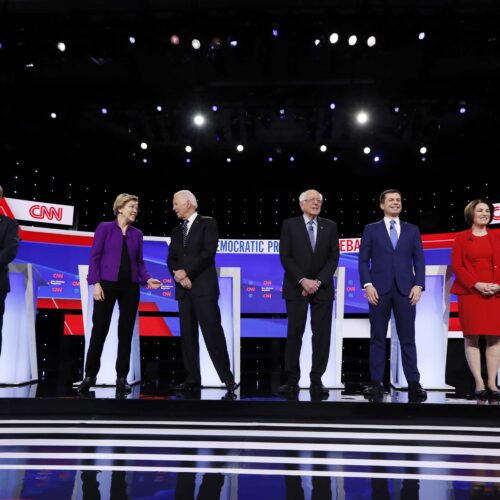Introduction
As 2020 began, about 4.5 million people had already contributed money to one or more Democratic presidential candidates — a major uptick from four years ago.
Democratic Party debate rules — collect lots of little contributions, get on the stage — encouraged candidates to prod, plead and beg for small-dollar donations, often in amounts as modest as $1, $5 or $10.
Candidates such as Sens. Elizabeth Warren and Bernie Sanders have even scorned wealthy donors (and some of their opponents’ tony fundraisers and wine cave soirées) while boasting about their own grassroots bona fides.
But despite directed attempts to attract more women, minority and middle-class donors, the 2020 Democratic presidential money chase isn’t nearly as proletariat as some candidates would like you to believe.
Taken together, the bulk of Democratic presidential campaigns’ campaign money comes from predominantly whiter, generally wealthier and relatively few places, according to a Center for Public Integrity analysis of federal campaign finance, U.S. Census Bureau and Social Security Administration data.
And while a randomly selected Democratic presidential campaign donor would most likely be a woman, the overall dollars donated tilt toward men, who tend to contribute bigger bucks.
These fundraising trends are notable given how Democrats have drawn connections between the lack of equal representation in politics and the lack of diversity among donors. The party advocates for elections where “all people, regardless of their income, can participate in the political process and can run for office without needing to depend on large contributions from the wealthy and the powerful,” per its national platform.
Public Integrity’s analysis looked at nearly 12.9 million donations made through the Democratic fundraising platform ActBlue or disclosed by candidates.
Among the revelations:
- Warren is the only candidate whose campaign donors are mostly women — and who raises a majority of her overall campaign cash from women.
- Former Vice President Joe Biden has received notably more contributions from women than men. But men account for the bulk of the money Biden has raised.
- Businessman Andrew Yang and Rep. Tulsi Gabbard, D-Hawaii, get the vast majority of their financial support from men.
- Coastal elites still rule — any given contribution is most likely to come from a large population center in the Northeast, West Coast or southern Florida. Sanders, Gabbard and businessman Tom Steyer have the most geographic diversity among their donors.
- Yang, Sanders and Gabbard are most likely to get their money from people living in racially and ethnically diverse ZIP codes. Who’s not? Sen. Amy Klobuchar, D-Minn.; Sen. Michael Bennet, D-Colo.; and former Massachusetts Gov. Deval Patrick.
More women gave. But a gender gap persists.
During Election 2020, female donors appear to give money to Democratic presidential candidates more often than men, according to an estimate using donor names. But on the whole, men give larger amounts. The result is a gender gap in dollars raised.
Specifically, about 46 percent of donors to Democratic presidential candidates are estimated to be male, but 51 percent of the money raised comes from men.
Forty-nine percent of donors to Democratic presidential candidates were estimated to be women, but 43 percent of the money raised was from those donors.
The remaining 6 percent of Democratic presidential donors are not easily classifiable.
Some Democratic presidential candidates rely significantly more on women for contributions than others.
ESTIMATED PERCENT RAISED BY EACH CAMPAIGN
Few places gave most
Democratic presidential campaign dollars were concentrated in population centers — primarily in the coastal Northeast and West Coast — such as New York City, Los Angeles, Washington, San Francisco, Chicago, Boston, Miami and Seattle.
DOLLARS RAISED IN EACH COUNTY BY ACTIVE CAMPAIGNS
The single largest source of money for Democrats was the New York City area, which gave $32 million dollars to currently active candidates. And within New York City, wealthy neighborhoods in Brooklyn and Manhattan give the most.
DOLLARS RAISED IN ZIP CODE BY ACTIVE CAMPAIGNS
Some candidates got more than 50 percent of their money from 19 populous urban areas, others fewers.
Wealthy places gave more
Overall, Democrats running for president in 2020 raised more from ZIP codes where the median household income was higher than that of people who voted for Hillary Clinton in 2016, according to a Pew survey — suggesting a mismatch between the economic interests of rank-and-file Democrats and the donors supporting presidential candidates.
This varied by candidate. Sanders, for instance, raised 38 percent of his presidential campaign money from places where the median household income was a modest $50,000-$74,999. To some degree, the rest of the Democratic presidential field is getting more of its money from wealthier places.
PROPORTION OF DOLLARS RAISED BY MEDIAN HOUSEHOLD INCOME OF ZIP CODE
More money came from whiter places
In 2016, 60 percent of Clinton voters were non-Hispanic and white. Among donors to presidential candidates in 2020, most live in ZIP codes where more than 60 percent of the population reflects the same demographic, according to Census Bureau estimates.
PERCENTAGE OF CANDIDATES’ CONTRIBUTIONS FROM ZIP CODES WHERE 60 PERCENT OR MORE RESIDENTS ARE NON-HISPANIC WHITE
Read more in Money and Democracy
Elections
‘Scam PAC’ treasurer sentenced to federal prison
Elections
With Michael Bloomberg, Democrats smash against their own anti-big money firewall
Will liberals stomach nominating a billionaire they like enough to defeat a billionaire they loathe?


Join the conversation
Show Comments